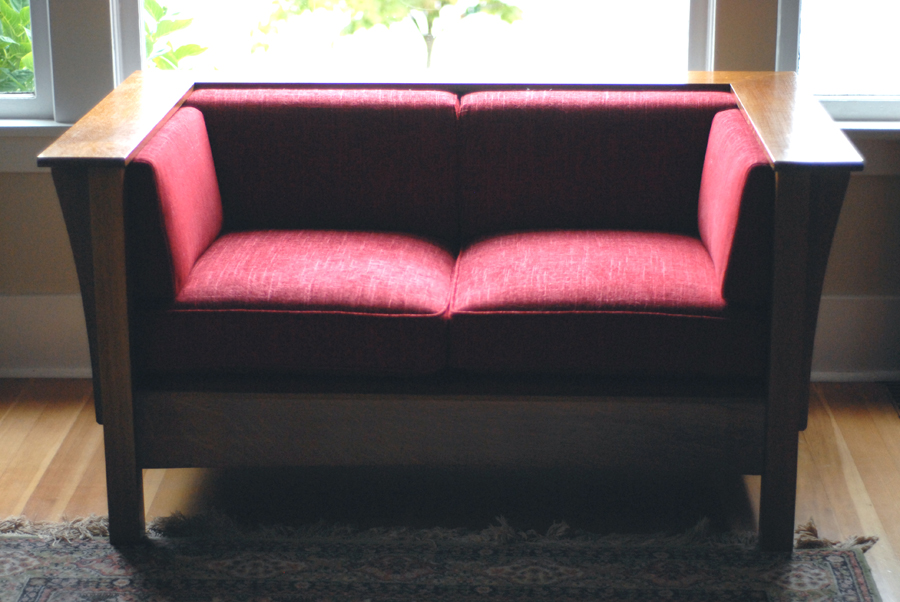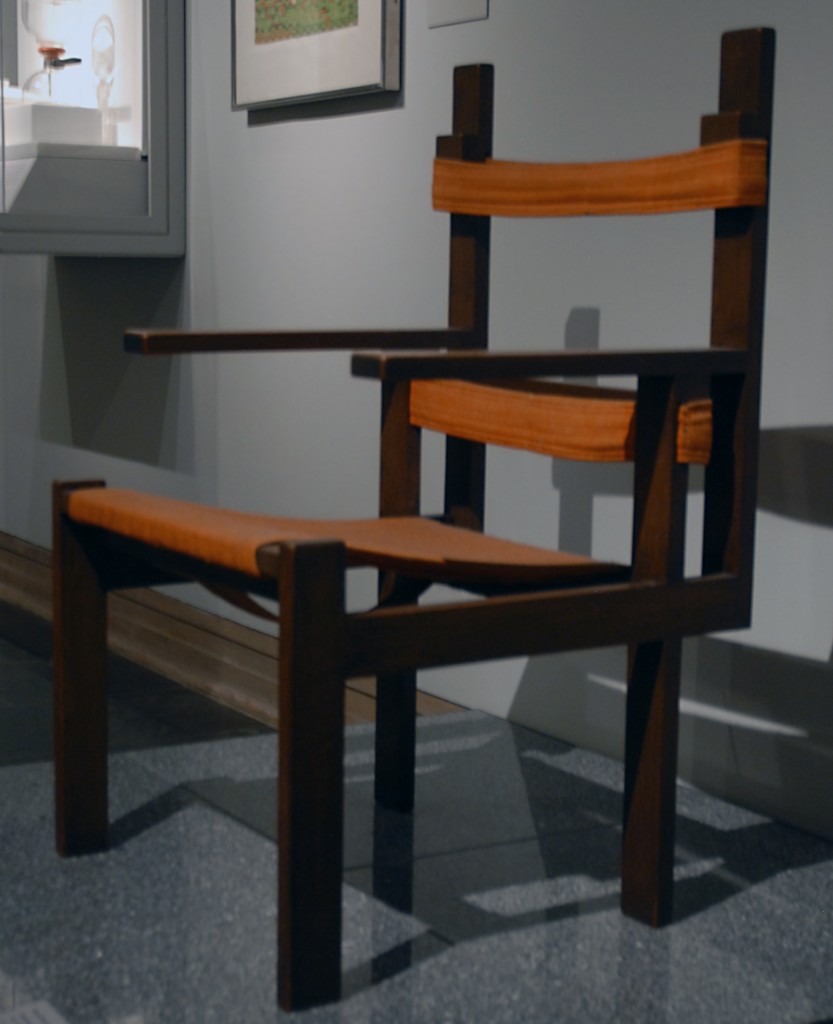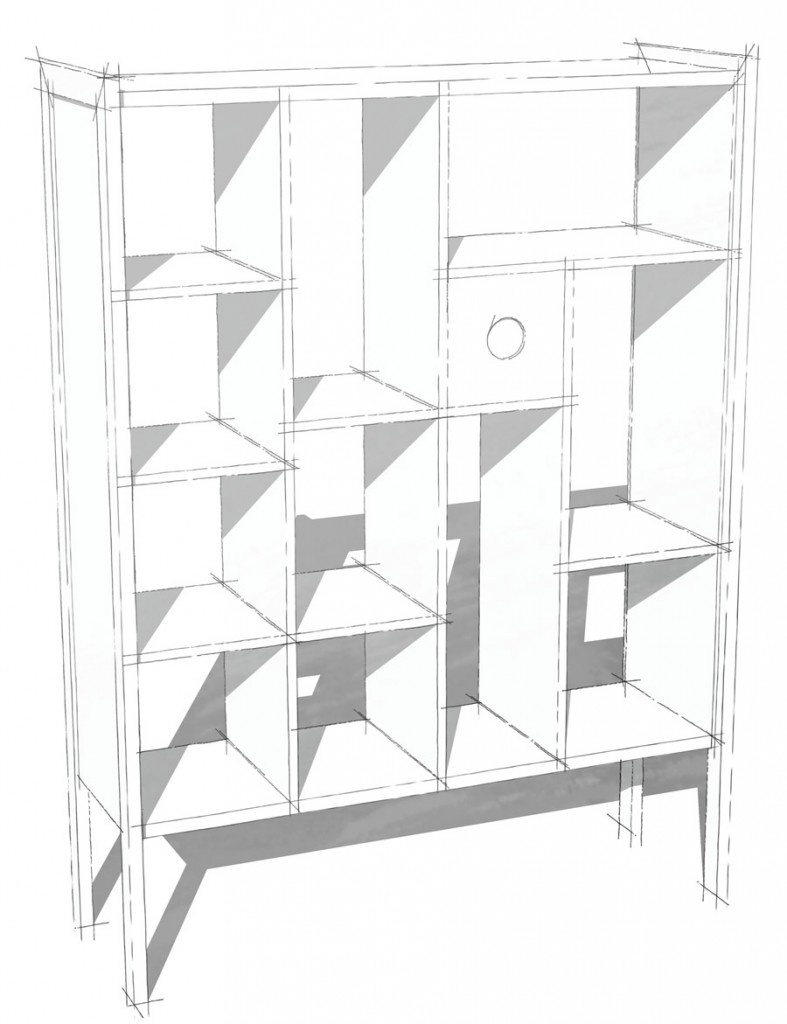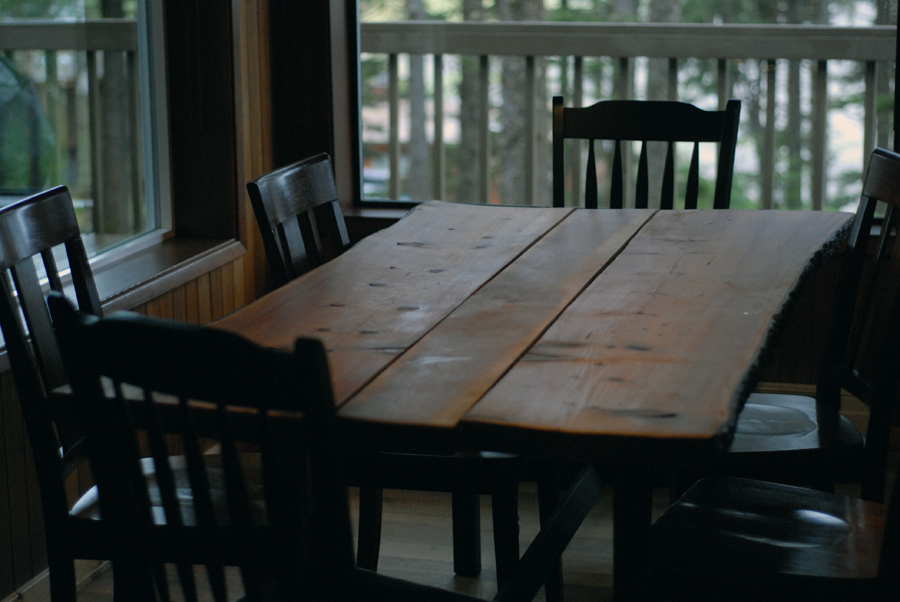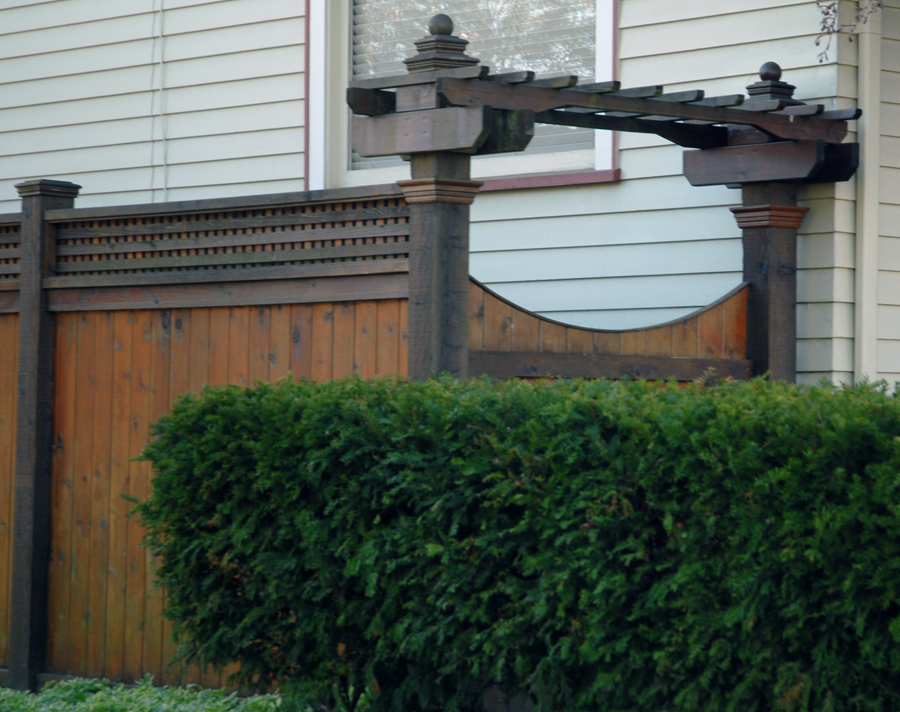I was skeptical of my own work towards the end of the settle build, but my doubts were alleviated by a trip to our upholsterer. He’d asked us to come into the shop to confirm the final look of the back and side cushions. Even with only the decking and bottom cushions complete at the point, the settle was looking really good. It’s now complete and installed, and we’re enjoying it–especially the dog.
Shop of the Crafters Server
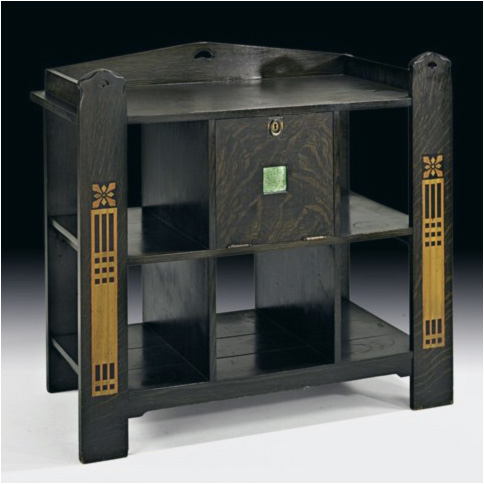
An Asian-inspired server by the Shop of the Crafters. Original auction posting at Liveauctioneers.
I’ve been researching furniture by various Arts & Crafts makers for my upcoming class on “Unknown Arts & Crafts” and came across this server by Cincinatti-based Shop of the Crafters. I would love to see the marketing material for the piece if it exists, since it might be the oddest server I’ve ever seen, beginning with the basic design and ending with the allusions to Chinese and Japanese forms. The server design eschews cupboards or drawers in favor of a grid of open shelves surrounding a single cupboard with a drop-front door decorated by an inset tile. The green of the tile calls to mind jade, and the ebonized finish evokes lacquerware. The cloudlifts on the front stretcher recur in Chinese furniture, and cutouts represent fans, another allusion to Asia. It’s a deliberate, if oddly mismatched effort to evoke Asia furniture, so the usual Shop of the Crafters inlay comes as a bit of shock, undermining the intent of the design.
Marcel Breuer at the Met
The placard accompanying Breuer’s armchair at the Met cites the strong influence of Dutch architect and designer on Gerrit Rietveld on this “de Stil-like” design. It also notes this is Breuer’s first use of a cantilevered frame. I find it interesting that it’s executed in wood where I associate most Bauhaus design with bent metal frames. In any case, it’s distinctive, if not necessarily comfortable . . .
Mid-Century Room Divider–Design
While the open floor plan is not without its appeal, it tends to work better when divided into functional zones. The folding screen, a staple of Arts & Crafts catalogs at the turn of the 20th century, is one way to help define these zones, but an open shelf like this design by an unknown maker accomplishes much the same effect without creating a solid barrier. The asymmetrical grid and single drawer liven the design, while construction is relatively straightforward. The two side frames capture the mitered case while dadoes house the shelves and vertical dividers. Half-blind dovetails join the sides and ends of the drawer box, but simpler joinery would suffice.
Unknown Arts & Crafts Web Seminar
 For those interested in learning more about Arts & Crafts furniture, I’ll be presenting “Unknown Arts & Crafts–Design Sources” for Popular Woodworking University. You can read more about the class here. Conversations about American Arts & Crafts furniture tend to begin and end with the work of Gustav Stickley. His reputation is deserved–and he inspired countless imitators–but some of Stickley’s contemporaries produced Arts & Crafts furniture that offered unique interpretations of the Arts & Crafts ethos. In this session, we’ll examine seminal works from these noteworthy makers.
For those interested in learning more about Arts & Crafts furniture, I’ll be presenting “Unknown Arts & Crafts–Design Sources” for Popular Woodworking University. You can read more about the class here. Conversations about American Arts & Crafts furniture tend to begin and end with the work of Gustav Stickley. His reputation is deserved–and he inspired countless imitators–but some of Stickley’s contemporaries produced Arts & Crafts furniture that offered unique interpretations of the Arts & Crafts ethos. In this session, we’ll examine seminal works from these noteworthy makers.
Mogensen-inspired Bookcase–Construction
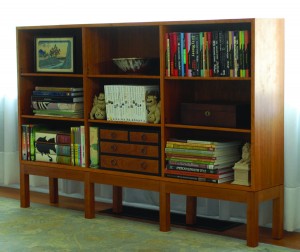
This console variation turns a Mogensen design on its side. See more about the original here.
It’s only after building this variation on a Børge Mogensen design that I fully appreciated the original. Normally I like an apron set back from legs to vary the plane of a base, but here the legs are set flush with the base aprons, and the entire base is flush with sides of the case, presenting what should be a monolith, but the cove along the top of the base interrupts the facade. Too, Mogensen creates variation elsewhere, making the shelves thinner than the case stock and setting the edges of the shelves back from the plane of the case front.
Aside from the mitered case sides, construction was pretty straight forward. Mortise and tenons join the base, which is then coved, and dadoes house the dividers. To cut the miters, I used a large chamfer bit and clamped a fence to the edge of the board to guide the bearing–a simple setup that let me bring the tool to some large pieces of stock and also avoided fussing with a router table. I cut the miters in multiple passes, slowly easing into a finished cut. Sadly cutting the joints was the easy part; glue up proved a little more problematic. For such a large assembly, I couldn’t tape the edges and roll the case up after applying glue. Instead I glued the dividers to the case top and bottom, then glued one side at a time, clamping the side to a diver and using clamps to along the side to bring the miter together. After considering options for base attachment, I drilled some pocket holes in the aprons and screwed the base to the case. Shelf hole liners finish the raw shelf pin holes.
Mogens Koch Modular Bookcase
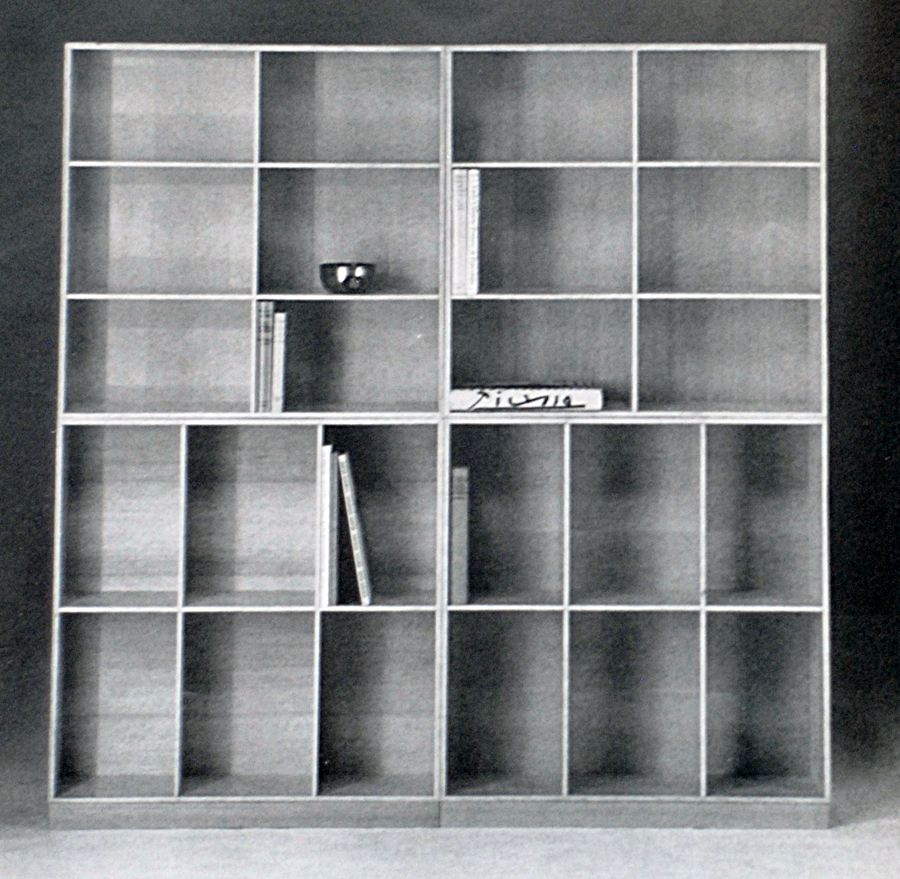
Koch’s square case can be oriented along either axis to adapt to storage needs. It can also be assembled into varying configurations. Image from Modern Danish Furniture.
Researching my latest book project, I cam across this modular shelf unit by Mogens Koch. The case can be oriented on either axis depending on storage need. And since the units are modular, they can be built up into multiple configurations. A stand and doors allow further customization. The cases are dovetailed, which surprised me a little, but it makes sense since these are made from solid stock. Here’s a group assembled as a wall unit at 1stdibs.
Finn Juhl Wall Unit
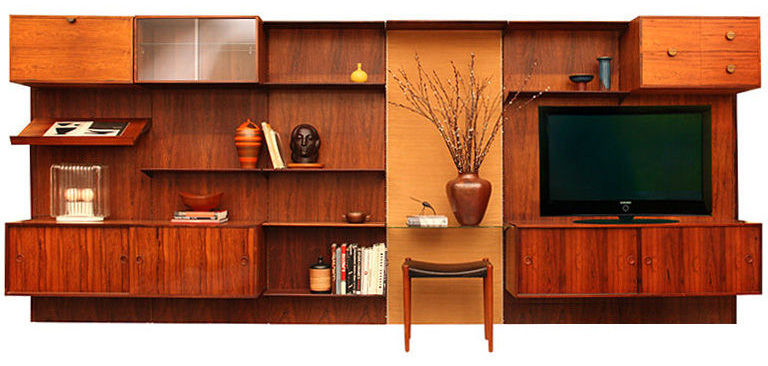
Finn Juhl designed this attractive wall unit in rosewood. Available from Wyeth via 1stdibs.
I’ve been looking at a lot of wall units as part of my latest book project, and my favorite has to be this one by Finn Juhl. I didn’t think shelf brackets could look so good. Part of it is the excellent staging and photography by Wyeth, but the piece itself shows good design coupled with capable manufacturing. Tt uses the rosewood grain to good effect, and I like the contrast of wood and reed. The piece is completely wrong for our space, but I’d love an excuse to build something like it. Not a situation very forgiving of mis-measurements, though . . .
A Rustic Dining Table
We recently spent a couple of days on the Washington coast. The cabin had been recently renovated in what I’d call “Pacific Northwest Rustic.” Imagine lots of fir slabs used as benches and shelves, and featured prominently in this dining table. The top consists of a couple of small slabs and a fill strip, all attached to the welded steel base through the bottom so fasteners won’t show. If the top was ever level, it isn’t now–there’s a noticeable amount of cup to the slabs, but I can’t tell if that’s because the boards were inadequately dried before construction or because only the top was finished. It’s a suitable design for the space and location and was probably reasonably economic to produce–both key factors to consider when furnishing 28 cabins. Were I to build something similar, though, I think I’d opt for a trestle base in wood. And the top is the perfect place for some butterfly keys.
A Tongue-and-Groove Infill Fence
The dog and I often pass this fence on our morning walks. The height and use of 6 x 6 posts make it a bit imposing, and the use of tongue-and-groove boards create a solid privacy border. The slat spacing on the lattice renders it relatively impermeable as well, an effect (if deliberate) that might have been better accomplished with a solid board or two.
The gate features an attractive reverse arch at the top trimmed with a thin strip to prevent water absorption through the board ends, an instance of form complementing function. The gate way, though, leaves something to be desired in the execution of the stacking of elements. Better (though more effort) to half-lap at least one of those layers

